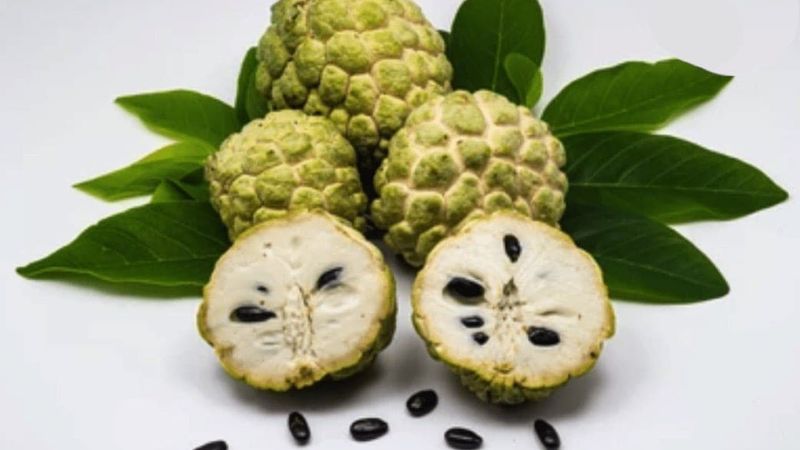

Our Review Process
Our articles undergo extensive medical review by board-certified practitioners to confirm that all factual inferences with respect to medical conditions, symptoms, treatments, and protocols are legitimate, canonical, and adhere to current guidelines and the latest discoveries. Read more.
Our Editorial Team
Shifa Fatima, MSc.
Author
Dr. Apoorva T, MHM.
MEDICAL ADVISOR
Is Custard Apple Good for Diabetes?
With a flavour similar to apples and a hint of banana, the humble custard apple is a storehouse of nutrients. The seasonal fruit, which contains vitamin E, magnesium and potassium, is loaded with health benefits and offers an instant energy fix.
Also known as sitaphal or sharifa, custard apple fights inflammation and aids immunity. Is custard apple good for diabetes, though? While the creamy fruit presents a sweet treat, it does help control the symptoms of diabetes, owing to a low glycemic index and high glycemic load.
Table of Contents
Custard Apple Benefits for Diabetes
Custard apple glycemic index custard apple is low at 54, making it fit to be consumed by persons with diabetes. It contains polyphenolic antioxidants that help regulate blood sugar by boosting insulin production and glucose absorption. This makes custard apples a fruit with a high glycemic load.
Packed with dietary fibre, a custard apple helps with digestion and keeps you feeling full for longer. This reduces the risk of diabetes by keeping blood sugar levels in control. Custard apples should be ideally consumed after breakfast or lunch to curb hunger pangs.
Custard apple boosts immunity, helps improve vision, and promotes heart health. Being a rich source of potassium and magnesium, custard apples also help maintain blood pressure. All of these benefits make custard apples good for diabetes.
Can Diabetics Eat Custard Apple?
Tropical fruit custard apple, also known as sugar apple, is heavy in sugar and carbs and, when ingested in excess, can quickly raise blood sugar levels. As a result, custard apples should only be consumed seldom by those with diabetes.
Custard apples do, however, also include a number of important vitamins and minerals, such as potassium, vitamin A, and C. It is also a good source of dietary fibre, which supports digestive health and can help control blood sugar levels.
Ways to consume Custard Apples for Diabetes
The ripe fruit can be consumed in its raw form and does not spike blood sugar levels if consumed in moderation. You can cut it into small slices or scoop it directly from the skin. Moreover, custard apples can be added to yoghurt, oatmeal, or smoothies.
Diabetes patients can eat custard apples. However, it is best to avoid drinking water after consuming any fruit, including custard apples. This can interfere with the absorption of nutrients, affect the digestive process, and increase acidity.


Is Sitaphal Good for Diabetes?
Tropical fruit sitaphal, commonly referred to as custard apple, is naturally rich in sugar and carbs. Sitaphal should therefore only be consumed occasionally by those who have diabetes.
Nevertheless, dietary fibre, vitamin C, and vitamin A are among the many important nutrients that sitaphal is a good source of. Sitaphal's fibre can assist maintain digestive health and regulate blood sugar levels.
Nutritional Profile
Custard apples are packed with nutrients and healthy dietary fibre. These are full of vitamins C and A, besides being rich in phosphorus, magnesium, calcium, zinc, iron – all of which make the fruit a great source of antioxidants. It is also rich in flavonoids and carotenoids.
A small-sized custard apple, which makes for a 100-gram serving, gives around 100 Kcal of energy and contains 25 grams of carbohydrates. It has 2.4 grams of dietary fibre, 1.7 grams of protein, zero cholesterol, and just a trace amount of fat. It contains the following micronutrients:
- Potassium: 382 mg
- Calcium: 30 mg
- Vitamin C: 19.2 mg
- Magnesium: 18 mg
- Sodium: 3 mg
- Vitamin A: 33 IU
Custard apples aid digestion and offer anti-ageing effects on the body. However, it is often unclear whether people with diabetes can eat custard apples. Read the next section to find out if this fruit is diabetes-friendly.
How frequently do you consume Custard Apples?
Sitaphal packs in a bunch of nutrients that offer multiple health benefits. One should nonetheless be mindful of the amount to be consumed in a day. Nutritionists recommend eating a custard apple after breakfast or lunch to draw its maximum benefits. Ideally, you should stick to consuming one custard apple every alternate day.
If you are watching your weight, avoid consuming large amounts of custard apples. This can also make you gain weight since the fruit is loaded with calories. When eaten in moderation, custard apples promote healthy weight gain.
Risks of Overconsumption
- As mentioned earlier, over-consumption of custard apples can lead to weight gain. Excess weight increases the risk of diabetes and also puts undue stress on vital organs and bones.
- Eating too much of the fruit can lead to a spike in blood sugar since it consists mainly of fructose and glucose.
- The fruit can interact with some diabetic medications, so it is best to consult your doctor for a quantity that can be safely consumed.
- Avoid eating the seeds or skin or custard apples. These have toxic compounds that can impact the functioning of the nervous system and the brain.
If you are still unsure of consuming custard apples, you may choose another fruit with a low glycemic index. Apple, grapefruit, kiwi, cherries, berries, and avocados are great alternatives.
Other health benefits of Custard Apple
- The Sanskrit words sheet, which means cool, and phal, which means fruit, combine to form sitaphal. True to its name, the fruit has cooling effects on the body. It prevents high blood pressure, thus maintaining heart health, and cuts down the risk of cancer.
- Antioxidant properties of the fruit help fight inflammation in the body, boost immunity and help improve vision. Custard apples are also used in the treatment of tumours. It is said to help treat skin infections, acne, allergies, and abscesses.
- The fibre in the fruit aids digestion, while calcium and magnesium promote strong bones. The fruit also contains vitamin B6, which helps ease symptoms of PMS.
- Boil three leaves of custard apples and consume the water every morning. Its leaves are rich in antioxidants that boost insulin production and prevent an increase in blood sugar levels.
Bottomline
With a low glycemic index of 54, custard apples promote insulin production and help stabilise blood sugar, making them suitable for persons with diabetes. The fruit contains powerful antioxidants and nutrients, boosting immunity, fighting inflammation, and promoting heart health.
Custard apples can be sourced locally and is an excellent addition to the diet. It can be eaten raw or added to yoghurt or oatmeal to boost flavour. However, one should be careful to consume this fruit in moderation as even naturally-occurring sugars can cause weight gain and blood sugar spikes.
References
- https://www.healthshots.com/healthy-eating/superfoods/custard-apple-benefits-in-reducing-risk-of-diabetes-and-blood-pressure/
Disclaimer
This website's content is provided only for educational reasons and is not meant to be a replacement for professional medical advice. Due to individual differences, the reader should contact their physician to decide whether the material is applicable to their case.








